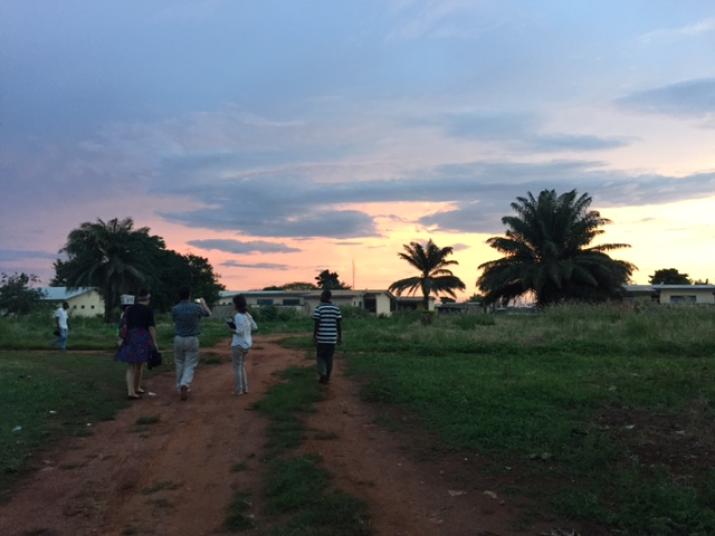
Behind a hospital in Goaso in the Brong-Ahafo region after a day of working with a student at the hospital
Published July 21, 2015, last updated on June 3, 2020 under Voices of DGHI
By John Victor Alencar
One advantage of being part of the SRT Ghana project, aside from getting to work with so many inspiring students, healthcare providers, and leaders in the field of anesthesia, is getting the chance to travel all around the country.
The fourteen hospital sites we will visit during our time here is spread within six of the nation’s ten regions and eleven towns and cities, from rainy Sunyani in the Brong-Ahafo region to dusty Tamale in the northern region, from the big cities of Accra and Kumasi to rural regions like the Upper West and the eastern regions. This difference in our project allows us to explore and see the great diversity in beauty and culture in this West African country, but our exposure to the circumstances and challenges of a project of this scale, and of global health in general, is perhaps even more valuable.
The nurse anesthetist students enrolled in the distance learning program work and live in very different settings. The size of their communities varies substantially. Some sites are in highly urban environments with larger populations surrounding it, while other sites are in small towns and communities in rural Ghana. Many of the hospitals offer broad services, while a few specialize in certain types of care like obstetric or orthopedic. Hospitals can be subdistrict, district, regional, or teaching hospitals – which correspond to their size and range of services. Also, regional differences between hospitals are also notable, as each hospital must be well versed in the cultural dynamics of their communities.
Each hospital situation paints a different picture to the experience of student nurse anesthetists in our program. The surgeries they practice can be very different both in type and in technique. Access to ventilators, anesthetics, and blood varies widely between sites, and the amount of staff and their expertise also differs. This diversity in workplace allows for a great exchange of ideas when the students meet each other when they return to the University of Development Studies (UDS). Their time in UDS and learning from the program, professors, and other students also allows them to bring back knowledge and improvements back to their hospitals.
However, having these very different sites and experiences are challenges for the program. The distance needed to travel from places like Accra and Koforidua to the UDS campus for exams and monthly lectures is long which means more costly and dangerous. Work schedules can be very hectic leading to little time for students to dedicate to the studying for the program. Despite the benefits to the distance program, hospital administration might not be supportive of their nurse anesthetists pursuing further education. And, of course, wi-fi access, especially in more rural and poorer regions, is a major challenge.
It has been very enlightening to hear about not only the benefits but the difficulties that the students face, because their responses highlight the areas of needed improvement for the future success of the distance program. It has also been important for us to visit each of these sites. Putting in the time and energy to trek to more remote places is extremely valuable when we are able to see their hospitals in person and place their responses in context.
Our experience has exposed us to the challenges of large scale interventions in global health. Although a distance program fits the needs of a country with a shortage of nurse anesthetists, there is so much more that must go in the structure of the program in order for it to work in any setting. This program started only one year ago, and it has already been through many changes. So, it is important for a program of this scale to be flexible and evolve with the needs of its communities.


